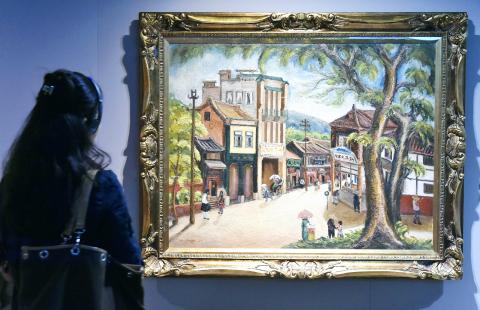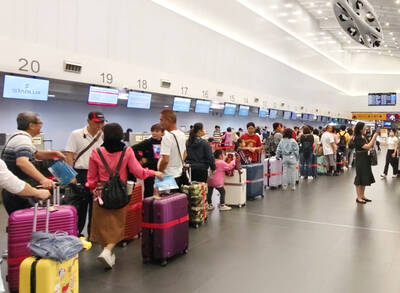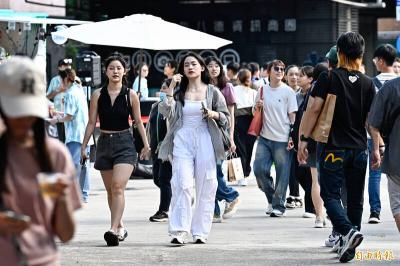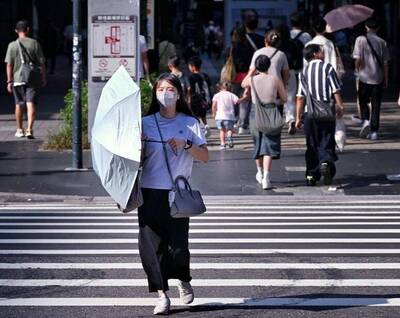Prints of paintings by famed Taiwanese painter Chen Cheng-po (陳澄波) are to go on tour in the US from Monday, with the aim of introducing Chen’s art and Taiwanese culture to Western viewers.
The touring exhibition is to start at the University of Wisconsin-Madison and the Madison Senior Center, where 42 prints will be exhibited from Monday to April 22, the Ministry of Culture said.
They will include prints of some of Chen’s best-known paintings, such as his Self-Portrait (自畫像), Sunset in Tamsui (淡水夕照) and Chiayi Street Scene (嘉義街景).

Photo: Chen Yi-chuan, Taipei Times
“It will be the first time that such a comprehensive exhibition of Chen’s works will have taken place in the United States,” said Chen Li-po (陳立柏), the grandson of the painter and executive director of the Chen Cheng Po Cultural Foundation.
He said the foundation has donated the prints to the North American Taiwan Studies Association, Wisconsin Chapter, which is a joint organizer of the Wisconsin exhibitions, because it has been moved by the passion of overseas Taiwanese students.
“They told me they have been making dumplings and performing Taiwanese glove puppetry for years to introduce Taiwanese culture to their American peers,” and hope to do something different this year, Chen Li-po said.
In addition to the prints, the exhibitions will showcase manuscripts, newspaper clippings, photos and studies from Chen Cheng-po’s lifetime, he said.
“We hope to introduce the entire time period through Chen Cheng-po’s works. It is not simply a one-man exhibition,” he said.
After Wisconsin, the prints will be showcased at Harvard University in June, followed by other universities, Chen Li-po said.
On April 13, Taiwanese graduate students will hold a concert at the Madison Senior Center, performing music inspired by Chen Cheng-po’s paintings and life, the Ministry of Culture said.
Born in Chiayi in 1895, Chen Cheng-po is often described as a pioneer in the development of art in modern Taiwan.
In 1924, he went to Japan to study at the Tokyo School of Fine Arts — now the Tokyo University of the Arts — and became the first Taiwanese artist to have his work featured in the Imperial Art Exhibition, a prestigious show in Japan at the time.
He then traveled to Shanghai, where he lived and taught from 1929 to 1933 and was influenced by Chinese ink paintings.
In 1933, he returned to Taiwan before the Second Sino-Japanese war and devoted himself to promoting aesthetic education. 0
The painter was shot dead in March 1947 during the Chinese Nationalist Party’s (KMT) brutal crackdown on anti-government uprisings that began on Feb. 27, 1947 — known as the 228 Incident — 16 months after Japanese colonial rule ended.
He was selected as one of six representatives in Chiayi to negotiate for peace with the KMT, but instead was captured and executed in public two weeks later in front of the Chiayi Railway Station.

Three Taiwanese airlines have prohibited passengers from packing Bluetooth earbuds and their charger cases in checked luggage. EVA Air and Uni Air said that Bluetooth earbuds and charger cases are categorized as portable electronic devices, which should be switched off if they are placed in checked luggage based on international aviation safety regulations. They must not be in standby or sleep mode. However, as charging would continue when earbuds are placed in the charger cases, which would contravene international aviation regulations, their cases must be carried as hand luggage, they said. Tigerair Taiwan said that earbud charger cases are equipped

Foreign travelers entering Taiwan on a short layover via Taiwan Taoyuan International Airport are receiving NT$600 gift vouchers from yesterday, the Tourism Administration said, adding that it hopes the incentive would boost tourism consumption at the airport. The program, which allows travelers holding non-Taiwan passports who enter the country during a layover of up to 24 hours to claim a voucher, aims to promote attractions at the airport, the agency said in a statement on Friday. To participate, travelers must sign up on the campaign Web site, the agency said. They can then present their passport and boarding pass for their connecting international

Temperatures in northern Taiwan are forecast to reach as high as 30°C today, as an ongoing northeasterly seasonal wind system weakens, the Central Weather Administration (CWA) said. CWA forecaster Tseng Chao-cheng (曾昭誠) said yesterday that with the seasonal wind system weakening, warmer easterly winds would boost the temperature today. Daytime temperatures in northern Taiwan and Yilan County are expected to range from 28°C to 30°C today, up about 3°C from yesterday, Tseng said. According to the CWA, temperature highs in central and southern Taiwan could stay stable. However, the weather is expected to turn cooler starting tonight as the northeasterly wind system strengthens again

Taiwan sweltered through its hottest October on record, the Central Weather Administration (CWA) said yesterday, the latest in a string of global temperature records. The main island endured its highest average temperature since 1950, CWA forecaster Liu Pei-teng said. Temperatures the world over have soared in recent years as human-induced climate change contributes to ever more erratic weather patterns. Taiwan’s average temperature was 27.381°C as of Thursday, Liu said. Liu said the average could slip 0.1°C by the end of yesterday, but it would still be higher than the previous record of 27.009°C in 2016. "The temperature only started lowering around Oct. 18 or 19